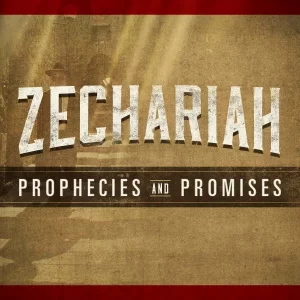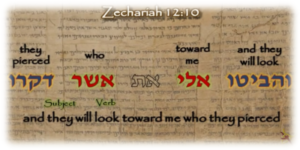Death Wound of the Messiah

Zechariah authored his prophetic book about the same time Zerubbabel led the Jews from Persia back to Jerusalem to rebuild the city and the Temple destroyed by Nebuchadnezzar. Setting the historical familial context, Zerubbabel, was the grandson of Jeconiah, the last sitting king in the House of David,
Recognized as a prophecy by both Jewish and Christian authorities alike is Zechariah 12:10 – with a few twists. Within each of their own Jewish ranks are differing views about the meaning of the verse.
Jewish sage Rabbi Rash, in The Complete Jewish Bible with Rashi Commentary referred to Sukkah (Succah) 52a, highlights an interesting debate that took place among the Talmud Rabbis. Initially, the rabbinic discussion focused on the topic of lust – whether men and women should be separated during worship and mourning services.
Rabbi R. Judah expressed through a question asking if the verse meant the Holy One would slay the Evil Inclination in the presence of both the righteous and the wicked during the Messianic age. The Rabb’s question changed the discussion:
Sukkah 52a:
“What is the cause of the mourning?
“R. Dosa and the Rabbis differ on the point. One explained, The cause is the slaying of Messiah the son of Joseph, and the other explained, The cause is the slaying of the Evil Inclination. “It is well according to him who explains that the cause is the slaying of Messiah the son of Joseph, since that well agrees with the Scriptural verse, And they shall look upon me because they have thrust him through, and they shall mourn for him as one mourneth for his only son; “but according to him who explains the cause to be the slaying of the Evil Inclination, is this [it may be objected] an occasion for mourning? Is it not rather an occasion for rejoicing? Why then should they weep?[2]
With that question, the dialog switched direction generating a debate around the prophetic nature of Zechariah 12:10 itself.[1] Jewish sages have generally concurred that Zechariah 12:10 refers to the Messiah and Rabbi Rashi later agreed with that meaning, too, in his commentary:[3]
“…as one mourns over an only son: As a man mourns over his only son. And our Sages expounded this in tractate Sukkah (52a) as referring to the Messiah, son of Joseph, who was slain.” – Rabbi Rashi[4]

Christian and Hebrew translations pose the biggest controversy centering around one Hebrew word, daqar. Translation of the word as either “pierced” or “thrust him through” is the issue.
Zech. 12:10 “And I will pour upon the house of David, and upon the inhabitants of Jerusalem, the spirit of grace and of supplication; and they shall look unto Me because they have thrust him through; and they shall mourn for him, as one mourneth for his only son, and shall be in bitterness for him, as one that is in bitterness for his first-born.” – Jewish Publication Society
Zech. 12:10 “And I will pour on the house of David and on the inhabitants of Jerusalem the Spirit of grace and supplication; then they will look on Me whom they pierced. Yes, they will mourn for Him as one mourns for his only son, and grieve for Him as one grieves for a firstborn.” – New King James Version
Jewish Bibles commonly read the Messiah will be “thrust through,” while most Christian Bibles typically translate daqar as pierced, such as by nails.[5] Neither of the interpretations are manifestly consistent with historical scriptural usage of the word.
Good News Translation and God’s Word Translation interprets daqar as “stabbed.” The Message and Contemporary English Version each translate the prophecy as piercing with a spear. Another takes the middle road with Bible in Basic English saying “wounded by their hands.”[6]
Regardless if the Hebrew word is translated as “pierced” or “thrust through,” none of the interpretations clearly solves the dilemma of the manner of how the wound was to be inflicted – by nails or by a weapon? The answer may be found through scriptural language analysis.[7]
Nine other times the Hebrew word daqar appears in the texts of the Old Testament/Tanakh including another appearance of the word in Zechariah.[8] In all instances, daqar is used in the context of wounds inflicted by a type of weapon, such as a sword or spear. Applying this word usage definition to Zechariah 12:10, the wound was inflicted by means of a type of weapon.
John’s Gospel account of the crucifixion and Resurrection of Jesus of Nazareth describes how he was both pierced by nails and had a spear thrust into his side when he was crucified.[9] Later, John described the resurrected Jesus who suddenly appeared in a locked room where he invited the doubting Disciple Thomas to touch the healed wounds in his hands, feet and in his side. Taking the offer, the doubtful Thomas exclaimed in an excited utterance , “My Lord and my God!”[10]
Were the Gospel accounts of the Jerusalem crucifixion of Jesus of Nazareth a fulfillment of the Zachariah 12:10 prophecy when the slain Messiah was deeply wounded by means of daqar?
Updated February 20, 2025.
This work is licensed under a Creative Commons Attribution-NonCommercial-NoDerivatives 4.0 International License.
REFERENCES:
[1] Sukkah 52a. Halakhah.com. Trans. Soncino Babylonian Talmud. n.d. pp 74-77, footnote #1-3. <http://www.halakhah.com/rst/moed/16b%20-%20Succah%20-%2029b-56b.pdf>
[2] Sukkah 52a, p 75. <http://www.halakhah.com/rst/moed/16b%20-%20Succah%20-%2029b-56b.pdf>
[3] “Rashi (Solomon Bar Isaac).” Jewish Encyclopedia. 2011. <http://www.jewishencyclopedia.com/articles/13862-solomon-b-isaac-rashi>
[4] The Complete Jewish Bible – with Rashi Commentary. Zechariah 12:10. <https://www.chabad.org/library/bible_cdo/aid/16216#showrashi=true>
[5] “daqar.” Lexicon-Concordance Online Bible. n.d. <http://lexiconcordance.com/hebrew/1856.html> Benner, Jeff A. Ancient Hebrew Research Center. “Zechariah 12:10 | “Pierced him” or “Pierced me?”” 2022. <https://www.ancient-hebrew.org/studies-verses/zechariah-12-10-pierced-him-or-pierced-me.htm> Benner, Jeff A. Ancient Hebrew Research Center. Zechariah 12:10. image. 2022. <https://www.ancient-hebrew.org/studies-verses/files/landing_zechariah.png>
[6] Contemporary English Verson; Good News Translation; God’s Word translation; Zechariah 12:10. BibleHub.com. 2020. <https://biblehub.com/zechariah/12-10.htm> The Message; Bible in Basic English. Zechariah 12:10. NetBible.org. 2020. <http://classic.net.bible.org/verse.php?book=Zec&chapter=12&verse=10>
[7] Sapir, Avinoam. LSI Laboratory for Scientific Interrogation, Inc. n.d. <http://www.lsiscan.com/index.htm> “SCAN – Scientific Content Analysis (Statement Analysis).” Advanced Polygraph. 2011. <http://www.advancedpolygraph.com.au/scan.htm> “Introduction to Text Analysis: About Text Analysis.” Duke University | Libraries. 2017. <https://guides.library.duke.edu/text_analysis> “What Is the Definition of Textual Analysis?” Reference.com. 2018. <https://www.reference.com/education/definition-textual-analysis-a95087916fcb24cb> Pfarrer, Mike “What is content analysis?” University of Georgia | Terry College of Business. 2012. <http://www.terry.uga.edu/management/contentanalysis>
[8] “daqar.” NetBible.org. Hebrew text. <http://classic.net.bible.org/search.php?search=hebrew_strict_index:01856>
[9] John 19. NetBible.org. Greek text. Strong. “nusso <3572>” CR Matthew 27; Mark 15; Luke 23.
[10] John 20.
